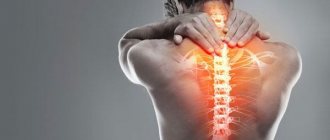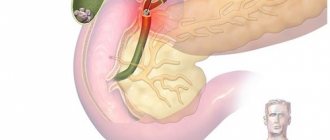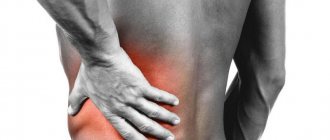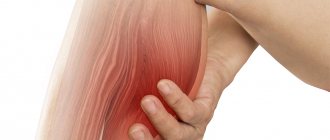The area where the pelvis connects to the spine experiences significant stress when moving and changing body positions. Therefore, the inflammatory process of the sacroiliac joint, or sacroiliitis, occurs quite often. Its designation in the International Classification of Diseases ICD-10 is M46.1. The disease can be independent or a side effect of tumor processes, infectious or autoimmune problems. A significant number of cases of lumbar sacroiliitis are observed in patients who were previously diagnosed with tuberculosis or syphilis. Depending on the cause that caused the appearance of painful symptoms, the nature and severity of the inflammatory process are distinguished.
Causes
The inflammatory process of the sacroiliac joint of bone tissue can be primary or secondary. The first is a local pathological process between the spinal column and the pelvic bones. It is provoked by tumor cells, infections and the consequences of untreated injuries. The secondary form is considered a side effect of infection or the development of connective tissue pathology, which results in rheumatic diseases.
The development of primary sacroiliitis is most often caused by:
- injuries to muscle and bone tissue in the lumbar and sacral region;
- benign and malignant neoplasms in the lower back that have metastasized to nearby tissues;
- infection of the pelvic area and lower back, consequences of purulent accumulations and damage to the skin.
According to medical statistics, primary tumors are more often caused by metastases from other organs: lungs, intestines or reproductive system. In the area of the articular connection of the pelvis and spine, the tumor process occurs relatively less frequently. The presence of metastases indicates a long development of the disease and indicates its chronic nature.
Secondary sacroiliitis of the hip joint is usually caused by pathologies such as types of arthritis, psoriasis, spondyloarthritis, infectious diseases: tuberculosis, syphilis, brucellosis. Each of the listed disease processes causes tissue suppuration, which is catalyzed by pathogens of infectious diseases. If there are signs of rheumatism, the patient experiences an aseptic inflammatory process, which has a negative effect on the condition of bone tissue and joints.
The most important
Sacroyelitis can occur independently or against the background of other pathologies. Most often the disease is caused by rheumatic diseases. If you experience pain in the lower back, which radiates to the thigh, buttocks, chest, or limited mobility, you should consult a doctor. It is important to conduct a thorough diagnosis to determine the exact cause of SIJ inflammation. Treatment of the pathology should be comprehensive: limiting physical activity, taking medications, physiotherapy, exercise therapy, massage, manual therapy. In advanced cases (for example, with purulent sacroyelitis), surgical treatment is performed. In the absence of timely treatment, dangerous complications arise that complicate the treatment of the pathology.
Symptoms
The first sign of the disease, which makes one aware of a pathological process in the lower back, is severe pain. Their intensity and degree of manifestation depend on the cause that caused the inflammatory process of the articular joint.
If sacroiliitis is caused by the development of systemic diseases, patients complain of:
- bilateral nature of the pain (with bilateral sacroiliitis), indicating damage to the sacroiliac joint to the right and left of the spine;
- intense pain in the lower back, radiating to the buttocks, groin area or thigh tissue;
- a sharp increase in pain during night sleep or prolonged rest;
- reduction of discomfort during intense physical activity and exercise;
- limited movement in the morning immediately after waking up.
If the development of inflammation in the joints is caused by infectious processes in the body, patients note symptoms such as:
- unilateral damage to the sacroiliac joint to the right or left of the spine (unilateral sacroiliitis);
- intense pain in the lumbar region, radiating to the leg;
- increased pain with increased physical activity, when pressing on a joint or trying to move the leg to the side;
- reduction in the intensity of pain during long periods of rest;
- swelling of the tissues in the sacral area, severe hyperemia and increased skin temperature.
When suppuration develops, patients complain of a tugging pain, which allows the doctor to accurately diagnose sacroiliitis and take measures to eliminate it. If the inflammatory process during sacroiliitis is caused by injury to bone tissue, examination of the body may reveal fractures of the pelvic bones and damage to muscle fibers.
Risk factors
In most cases, inflammation of the sacroiliac joint is diagnosed:
- in the presence of untreated traumatic lesions in the lumbar region;
- if the patient refuses treatment for complex infectious diseases;
- in case of development of tumor processes in the pelvic and peritoneal organs;
- with decreased immunity due to serious illnesses;
- in case of congenital or acquired joint pathologies.
The listed situations indicate the need for regular preventive examination and visiting a doctor for any signs of the development of pathological processes in the lumbar region, bone joints of the pelvis and spine. This will allow you to detect the disease at an early stage and achieve 100% relief from its dangerous symptoms.
Are you experiencing symptoms of sacroiliitis?
Only a doctor can accurately diagnose the disease. Don't delay your consultation - call
Diagnostic procedures
Various inflammatory conditions can cause or contribute to joint pain.
- If an inflammatory disease is suspected, a complete blood count should be performed (this should include erythrocyte sedimentation rate, C-reactive protein, antinuclear antibodies, human leukocyte antigen (HLA-B27) and rheumatoid factor). Although cancer is a much less common cause of sacroiliitis, if cancer is suspected, consider a blood test for tumor markers.
- X-ray studies. Conventional radiography remains the first line of imaging despite its low sensitivity and specificity in early onset disease. Radiographic findings include endplate sclerosis (especially on the iliac side), irregular articular endplates, and widened joint spaces.
- CT scan. CT scans provide greater sensitivity, accuracy, and detailed information compared to conventional radiography.
- Nuclear medicine. Bone scans demonstrate increased radioisotope activity in the SIJ and help localize the source of pain. It is also useful in ruling out stress fractures and other bone pathologies.
Classification
In order to develop more effective treatment tactics, the following classification methods are used:
- depending on the area of damage to the joint, they distinguish between synovitis (the inner layer of the joint capsule is affected), osteoarthritis (the disease affects the cartilage tissue) and panarthritis, when the inflammatory process affects the entire joint;
- Taking into account the nature and characteristics of the course, patients are diagnosed with purulent, subacute or chronic sacroiliitis. The first case is often the result of traumatic tissue damage, and the third is a consequence of infection of the body. Subacute sacroiliitis occupies an intermediate position between the acute and chronic stages, differing from the latter in more pronounced symptoms.
Complications of sacroiliitis 2 and 3 degrees
Further development of the inflammatory process without proper treatment and specialist supervision becomes the cause of a number of pathological conditions:
- suppuration can affect healthy tissues of the hip, back and lower extremities;
- inflammation of the joint impairs the nutrition of tissues, which can cause their gradual death and destruction;
- the development of the disease often acts as a factor in limiting the mobility of the joint and limb;
- disruption of the articular joint is often the cause of its destruction with subsequent immobilization of the patient.
Also, due to joint pathology, the risk of developing osteoporosis increases.
Diagnosis of sacroiliitis
The entire diagnostic technique of the disease in question lies in the study of clinical manifestations identified during the examination of the patient. A clarifying addition can be the results of additional research methods, the most important of which is considered to be x-ray.
The following diagnostic criteria are determined:
- intensity and nature of manifestation of existing symptoms;
- waking up at night due to discomfort;
- presence/absence of pain in the thoracic spine;
- study of existing inflammation;
- patient's medical history, taking into account various factors.
The main clinical signs remain:
- degree of limitation of mobility in the affected area;
- changes, violations of posture and the intensity of their manifestation.
Treatment
The course of drug treatment for sacroiliitis includes taking antibiotics, anti-inflammatory drugs and corticosteroids. When choosing appropriate medications, the doctor takes into account the age and general condition of the patient’s body, the degree of damage to the joint and the characteristics of the course of the disease. When diagnosing complex purulent inflammation, surgical intervention is indicated.
If sacroiliitis is detected at the initial stage, the patient is guaranteed a complete cure while maintaining mobility and integrity of the joint. If the chronic stage develops, the likelihood of eliminating symptoms directly depends on the extent of inflammation and destruction of the articular joint.
Prevention of sacroiliitis
Everyone knows that it is worthwhile to treat any disease in a timely manner, at the initial stages of its progression, or better yet, long before its onset, which can be real thanks to the observance of preventive measures, which usually include:
- monitoring general health, monitoring well-being;
- timely, complete treatment of various types of infections;
- protecting the body from overheating/hypothermia;
- creating conditions for strengthening and maintaining an optimal level of immunity.
Remember the benefits of leading an active lifestyle, ensure a balanced daily diet and enjoy all the pleasures of life without having to deal with various diseases.
Avoid self-medication and if any symptoms appear, please seek qualified medical help.
How to make an appointment with a rheumatologist at JSC "Medicine" (clinic of academician Roitberg)
To be examined by a qualified rheumatologist or traumatologist and receive recommendations for the treatment of sacroiliitis in our clinic, you can call +7 (495) 775-73-60. You can apply for an appointment online using the contact form on the website. Be sure to include your current phone number so that a call center employee can contact you and confirm your appointment time.
The clinic is located at the address: Central Administrative District, 2nd Tverskoy-Yamskaya Lane, 10. For those who travel by public transport, it is more convenient to get to the medical center from the Mayakovskaya, Belorusskaya, Novoslobodskaya, Tverskaya, Chekhovskaya metro stations.
Irradiation of the disease is sacroiliitis.
First degree
Sacroiliitis of the 1st degree very rarely manifests itself with severe symptoms. Nagging pain in the back and stiffness of the vertebrae may only occasionally occur after waking up in the morning. Lumbar pain can also radiate to the heel, and often to the Achilles tendon junction.
Second degree
Bilateral sacroiliitis (grade 2 of the disease), naturally, is manifested by pain in the buttocks, spreading to the thigh. Disturbances in the sacrolumbar region are accompanied by lumbago or paroxysmal pain. Mobility in the lower spinal region becomes difficult, often with physiological curvature of the lumbar zones.
Third degree
If the question arises, what is grade 3 sacroiliitis, then radiation diagnostics (x-ray examination) can answer it; it indicates partial or complete ankylosis of the sacrum and ilium. As a result of compression of the nerve root endings and displacement of the vertebrae, radiculitis (thoracic and lumbar), muscle cramps, attacks of asphyxia and increased blood pressure may occur.
Stretching exercises
To achieve the effect, you must perform individual exercises for at least one minute. While holding your body in a certain position, you need to relax and feel how the muscles stretch. Types of exercises:
- While standing, lunge forward with your right leg and bend your knee. Place your hands on your right limb, and try to bring the knee of your left leg closer to the floor. Slowly perform several forward bends. Then do the same with your other leg forward.
- Lunge again, but keep your leg straight, as if doing a split. Point your hands towards the floor. In this way, stretch both legs.
- “Butterfly” - in a sitting position, point your feet towards each other and connect. Watch your posture, bend your elbows. With your hands, grab your knees and press on them, trying to lower your knees to the floor. As you inhale, bend your body forward until you feel a stretch. Spend about a minute in this position, then stop putting pressure on your legs and straighten your back.
- Lie on the floor with your back, place your right lower limb on your left, and turn your body in the same direction. Return to the starting position, in a mirror position, do the same with the other leg.
- “Cat” - standing on all fours, bend your back down, and then you need to bend it in the opposite direction.









